Climbing is as much a mental challenge as it is a physical one. Despite its importance, mental preparation is often overlooked in favor of physical training. However, climbers know that reaching the top requires more than just physical strength; it demands a resilient mind.
The connection between the mind and body in climbing is undeniable. Mental barriers can prevent even the most physically capable climbers from achieving their full potential. By understanding and addressing these barriers, climbers can improve their performance significantly.
Just like physical training, mental preparation can be structured and practiced. This article will explore key mental training techniques, including visualization and fear management, to help climbers enhance their climbing abilities.
Key Takeaways
- Understanding the critical role of mental preparation in climbing.
- Recognizing how mental barriers impact climbing performance.
- Exploring structured mental training techniques.
- Learning visualization techniques for improved climbing.
- Managing fear to enhance climbing performance.
Why Mental Training Matters for Climbing Performance
For climbers, the journey to success is as much about mental preparation as it is about physical training. Mental strength is not just equally important compared to physical strength; it is often more crucial. As emphasized by experienced climbers, “Mental strength might prevent you from stepping off the ground on something that you are physically capable of.”
The significance of mental training in climbing cannot be overstated. It is what drives a climber to consistently show up at the training gym and tackle challenging routes. The mind comes before every action, whether it’s physical or mental training. Without resilience, which is developed through mental training, climbers wouldn’t be able to push their limits.
The Mind-Body Connection in Climbing
The connection between the mind and body is particularly evident in climbing. A climber’s mental state directly affects their physical performance on the wall. When climbers are mentally prepared, they can execute their physical skills more effectively. The mind-body connection is crucial because it influences how climbers perceive and respond to challenges.
Common Mental Barriers Climbers Face
Climbers often face mental barriers that can hinder their progress. Common barriers include fear of falling, fear of failure, and performance anxiety. These mental obstacles can prevent climbers from attempting routes they are physically capable of climbing. Understanding and addressing these barriers through mental training is essential for improving overall climbing performance.
| Mental Barrier | Impact on Climbing | Overcoming Strategy |
|---|---|---|
| Fear of Falling | Prevents attempting challenging routes | Gradual exposure to falling scenarios |
| Fear of Failure | Discourages climbers from pushing limits | Reframing failure as a learning experience |
| Performance Anxiety | Affects focus and execution under pressure | Pre-climb rituals and mental rehearsal |
Understanding the Psychology of Fear in Climbing
Fear is an inherent aspect of climbing that can either hinder or enhance performance. Climbers must navigate their fears to achieve success and enjoyment in the sport.
Fear of Falling vs. Fear of Failure
The two biggest fears that hold climbers back are the fear of falling and the fear of failure. The fear of falling tends to be more significant for new climbers, as it is a natural response to the risk of injury. On the other hand, the fear of failure is more prevalent among experienced climbers who have invested their ego in their climbing abilities. This fear can stem from the pressure to perform and the fear of not meeting personal expectations.
For instance, a new climber may be more concerned about falling off the wall, while an experienced climber may worry about not being able to complete a challenging route. Understanding these fears is crucial to addressing them effectively.

How Fear Affects Your Physical Performance
Fear triggers a physiological response in the body, often referred to as the “fight or flight” response. This response includes increased heart rate, muscle tension, and tunnel vision, all of which can directly impact climbing performance. When climbers are fearful, they may become more rigid and less coordinated, making it more difficult to execute precise movements.
Furthermore, fear can create a self-reinforcing cycle. The more a climber fears falling or failure, the more likely they are to experience anxiety, which in turn can increase the likelihood of falling or failing. Breaking this cycle requires a systematic approach to addressing and managing fear.
By understanding how fear affects physical performance, climbers can take steps to mitigate its impact and improve their overall climbing ability.
Essential Mental Training Techniques for Climbers
Effective mental training can make a significant difference in a climber’s ability to tackle challenging routes. Climbers who incorporate mental training into their practice often see improvements in their overall climbing ability. Mental training is not just about visualization; it’s about developing a comprehensive approach to improve performance.
Developing Self-Awareness
Self-awareness is the foundation of all mental training in climbing. It involves understanding your thought patterns, emotional responses, and physical reactions to different climbing situations. By developing self-awareness, climbers can identify areas that need improvement and work on building mental resilience. This can be achieved through practices like journaling, meditation, and reflection after climbing sessions.
For example, a climber can keep a journal to track their progress, noting what went well and what didn’t during a climb. This helps in identifying patterns and areas for improvement. Recognizing your strengths and weaknesses is crucial for targeted mental training.
| Self-Awareness Techniques | Description | Benefits |
|---|---|---|
| Journaling | Recording climbing experiences and thoughts | Identifies patterns and areas for improvement |
| Meditation | Practice mindfulness and focus | Improves mental clarity and calmness |
| Reflection | Analyzing climbing sessions | Enhances understanding of personal strengths and weaknesses |
Visualization and Beta Mapping
Visualization is a powerful tool for climbers, allowing them to mentally rehearse climbs and prepare for challenging sequences. Beta mapping is an extension of visualization, where climbers create detailed maps of a route, including key holds, moves, and crux sequences.
To create a beta map, start by studying the route, either in person or through images. Draw a detailed map, noting key features, moves, and holds. This process helps in memorizing the sequence of moves and anticipating potential challenges. Beta mapping can significantly enhance a climber’s preparation and confidence.
Rewriting Mental Scripts
Mental scripts refer to the internal narratives that climbers have about their abilities and performance. Negative scripts can hinder a climber’s progress, while positive ones can enhance it. Rewriting mental scripts involves identifying negative self-talk and replacing it with positive, empowering narratives.
For instance, a climber might replace the thought “I’m not good enough for this route” with “I’ve prepared well and can tackle this challenge.” Repeating positive affirmations can help in building confidence and improving performance. This technique, combined with visualization and beta mapping, forms a comprehensive mental training program.
By incorporating these mental training techniques into their practice, climbers can improve their performance, build resilience, and enhance their overall climbing experience.
Practical Exercises to Build Mental Strength
Effective mental training enables climbers to push beyond their limits and reach new heights. Climbers can develop the mental toughness needed to overcome obstacles through structured exercises.
Structured Fall Practice

Structured fall practice is a systematic approach to reducing the fear of falling. It involves a gradual exposure to falling, starting from low heights and progressing to more significant drops. This technique helps climbers become comfortable with the sensation of falling and builds trust in their equipment and safety protocols.
To implement structured fall practice, begin by practicing falls on a top rope in a controlled environment. Gradually increase the height of the falls as you become more comfortable. It’s essential to focus on proper rope management and lead climbing techniques to ensure safety.
Pre-Climb Rituals to Reduce Anxiety
Pre-climb rituals can significantly reduce anxiety and improve focus. These rituals can include safety checks, breathing exercises, and mental preparation techniques. By establishing a consistent pre-climb routine, climbers can calm their nerves and prepare themselves for the climb ahead.
Examples of effective pre-climb rituals include visualizing the climb, checking equipment, and performing relaxation techniques such as deep breathing. Professional climbers often use these rituals to manage their fear and stay focused under pressure.
Thought Replacement Strategies
Thought replacement strategies involve replacing negative self-talk with positive affirmations. This technique can help climbers manage their fear of failure and stay motivated. By focusing on positive outcomes and past successes, climbers can build confidence and reduce anxiety.
To implement thought replacement, identify negative thought patterns and challenge them with positive affirmations. For example, instead of thinking “I’m going to fall,” replace it with “I’ve practiced falling safely, and I’m prepared.”
Implementing the Think-Play-Send Approach
Effective mental training is crucial for climbers, and the Think-Play-Send approach offers a structured way to achieve it. This methodology involves three distinct phases designed to enhance a climber’s mental game and overall performance.
Think: Analyzing Your Mental Game
In the “Think” phase, climbers analyze their climbing to identify areas for improvement. This involves self-examination and gathering input from others to determine the skills that need development. A recent survey revealed that more than 75% of climbers spend less than 30 minutes a week analyzing their climbing to figure out how to improve. By dedicating more time to this analysis, climbers can create a targeted mental training plan.
To analyze your mental game, start by reflecting on your past climbing experiences. Identify the mental barriers that have held you back, such as fear or self-doubt. Consider seeking feedback from fellow climbers or mentors to gain new insights.
Play: Practicing in a Safe Environment
The “Play” phase involves practicing new mental skills in a safe and controlled environment. This could mean training on easier routes or boulders where you can focus on developing your mental techniques without the pressure of a challenging climb. By creating a safe space to practice, you can build confidence and refine your mental strategies.
Send: Applying Techniques on Real Projects
In the “Send” phase, climbers apply the mental techniques they’ve developed to actual climbing projects. This is where you put your training into practice, using the skills and strategies you’ve honed during the “Think” and “Play” phases. By successfully applying these techniques, you can enhance your performance and achieve your climbing goals.
| Phase | Description | Key Activities |
|---|---|---|
| Think | Analyzing your mental game | Self-examination, gathering feedback, identifying areas for improvement |
| Play | Practicing in a safe environment | Training on easier routes, developing mental techniques, building confidence |
| Send | Applying techniques on real projects | Putting training into practice, using developed mental techniques, achieving climbing goals |
By following the Think-Play-Send approach, climbers can systematically improve their mental training and enhance their overall climbing performance. This structured methodology helps climbers make the most of their training time and achieve their goals more effectively.
Conclusion
To reach new heights in climbing, one must not only train the body but also fortify the mind against the fears and doubts that can hold them back. The mental training techniques covered, from developing self-awareness to practicing visualization and beta mapping, work together to create a comprehensive approach to mental strength.
Consistent practice and patience are key when developing these mental skills. By dedicating time to mental training, climbers can overcome specific fears, such as the fear of falling or fear of failure, and break through performance plateaus. Integrating mental training into regular climbing sessions can lead to a more enjoyable and less anxious climbing experience.
By adopting these techniques and approaching mental training with the same dedication given to physical training, climbers can enhance their overall performance and experience. Start with small steps, and you’ll be on your way to building comprehensive mental strength.

